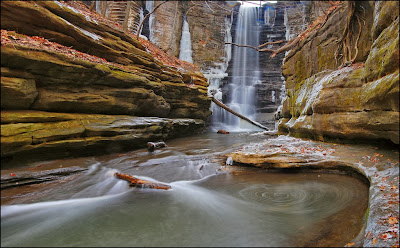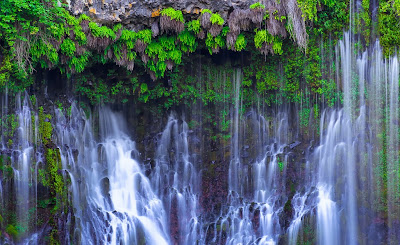 |
| Photo by: Arnar Valdimarsson |
Starlit sky, sea-shore, flowing river, waterfall etc. are natural features that make one never getting bored of seeing them again and again. Waterfall is an ever flowing subject and movement being its beauty; it is a tall order to capture all its appeal in a still photograph.
To make your image an enchanting one; strong composition is a must; the image should tell a unique story to the viewer about itself; the surrounding environment, the weather etc. A creative photographer should know how best to compose his/her waterfalls and use various techniques to achieve the desired effect. Here in this article we will discuss some compositional tips to help you better compose your waterfall photographs.
Make Use of Curves
 |
| Photo by: Ulrich Burkhalter |
When photographing waterfalls look out for curves, they are your best friends; graceful curves could add an element of elegance to your waterfall. Waterfalls with curves make a much more pleasing photograph than the ones in which the water simply falls straight down. Curves could be formed by the moving water, or by elements in the surroundings that could be used to lead the viewers’ eyes towards the subject.
Shoot at an Angle
 |
| Photo by: K.W.Sanders |
Instead of the shooting the waterfall directly from the front (which most people do) try to shoot it from an angle, it will make a much more interesting image. Remember just like in portraiture, where models often have a good side and a bad side, and portrait photographers always shoot so as to feature the good side of the model.
First explore the waterfall from both sides; it might look entirely different when viewed from another angle. Check every angle and make sure you shoot it from the best viewpoint, sometimes this means you will have to climb on a big rock or a tree or go further down the stream, spare no effort to capture the scene from a unique perspective.
Include the Environment
 |
| Photo by: Chris Chabot |
Waterfall derives much of its character from the immediate environment surrounding it, so try to include some of them in your waterfall shots, the environment should tell the viewer about the nature of the waterfall, where is it located, what’s around it etc. so just ignore the general advice that we receive when photographing other subjects of moving in close and cropping out unwanted details when photographing waterfalls. In waterfall photography the surrounding details could be just as important as your main center of interest.
Add a Foreground Element
 |
| Photo by: Tom Gill |
Whenever possible add some interesting element in the foreground. This simple technique will go a long way in improving the composition. Rocks, flowers, dead leaves on rocks etc make interesting foreground elements. If there is a pool of water below the falls, include it in your composition it adds an element of interest, especially so if there is a swirl of water happening.
Avoid the Sky if Possible
 |
| Photo by: Joe Parks |
Whenever possible avoid including the sky when photographing waterfalls. The sky will in most cases only act as a distraction. Also sky is usually much brighter than the rest of the frame and could easily skew your exposure.
Include a Fixed Feature
 |
| Photo by: Gary Simmons |
Water looks best when photographed using slow shutter speeds to capture some amount of blur which emphasizes motion. However having some fixed feature in the shot like rocks or some man-made structures can add context and interestingness to your shots. Also when including the surrounding foliage in your waterfall photographs you need to make sure that it is sharp, else it will ruin the shot. So be careful when shooting long exposure waterfall shots in windy conditions.
Rule of Thirds or Golden Mean
 |
| Photo by: Dylan Toh |
Photography compositional guidelines like the rule of thirds or the golden mean could be very helpful when deciding where to place the center of interest in your compositions.
Don’t Try to Capture it All
 |
| Photo by: Arbyreed |
This might sound contrary to the earlier tip of including the environment, but sometimes it is best not to include everything in a single shot, instead zooming in close and framing just a part of the scene could produce better results. Using the narrow angle of view afforded by a longer focal length lens, one could easily find many interesting compositions from within a single scene.
Shot in Both Landscape and Portrait Orientations
Always shoot a waterfall in both landscape and portrait orientations, even if you didn't like one when reviewing it in your camera’s LCD screen. You will never know which one looks best until you view the images in a large computer screen.
 |
| Photo by: Cedward Brice |
Waterfalls release tremendous amount of energy in to the atmosphere; and its power remains its appeal; a viewer should feel the impact simply seeing the photograph; in other words let the energy released by the falling water never go waste; convey it to the viewer; happy waterfalls and thundering images!
Post a Comment